The Neighborhood Gardener – June

Happy Gardening!
Prickly Pear
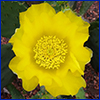 Prickly pear cactus may not give up easily to being eaten, but if you put in the work the payoff is worth the effort. Both the pads (nopales) and the red fruits can be eaten. The pads are said to taste a bit like green beans while the fruits are sweet. The flowers come in a range of warm-hued colors like orange, yellow, red, and pink, depending on the species and variety. Best yet, it thrives in sandy soil and requires little to no maintenance. More
Prickly pear cactus may not give up easily to being eaten, but if you put in the work the payoff is worth the effort. Both the pads (nopales) and the red fruits can be eaten. The pads are said to taste a bit like green beans while the fruits are sweet. The flowers come in a range of warm-hued colors like orange, yellow, red, and pink, depending on the species and variety. Best yet, it thrives in sandy soil and requires little to no maintenance. More
(Photo: Gary Knox, UF/IFAS. Used with permission, all rights reserved.)
Coreopsis Dye
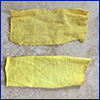 Egg-dying season may have passed but fiber-dying season could just be starting depending on what you have growing. We were interested in the prospect of using flowers from the garden to dye fabric, and the plethora of coreopsis blooming right now got us inspired. You can check out our tutorial on creating dye from these cheerful wildflowers. More
Egg-dying season may have passed but fiber-dying season could just be starting depending on what you have growing. We were interested in the prospect of using flowers from the garden to dye fabric, and the plethora of coreopsis blooming right now got us inspired. You can check out our tutorial on creating dye from these cheerful wildflowers. More
Planting Around Your Windows
 Breaking your landscape up into different areas can help you develop a design aesthetic. This can make an entire landscape overhaul seem less daunting. You can keep costs down by chunking it out and working on one area at a time, or you can just make changes to one area that has needed some attention. This month we discuss some tricks to making sure the landscaping around your windows is picture perfect. More
Breaking your landscape up into different areas can help you develop a design aesthetic. This can make an entire landscape overhaul seem less daunting. You can keep costs down by chunking it out and working on one area at a time, or you can just make changes to one area that has needed some attention. This month we discuss some tricks to making sure the landscaping around your windows is picture perfect. More
Wendy's Wanderings
 June is here and while most of the country is celebrating graduation and preparing for summer vacation, Floridians are preparing for hurricane season. My battery and flashlight drawers are ready and I will be thinking about my "go bag" contents later, because the phrase "sheltering in place" is equal to "riding the storm out" and I'm not sure I'm ready to do that again. Luckily for us the season doesn’t usually heat up until a little later in the summer, so now is a perfect time to take stock of your trees and landscape and to get a plan together. More
June is here and while most of the country is celebrating graduation and preparing for summer vacation, Floridians are preparing for hurricane season. My battery and flashlight drawers are ready and I will be thinking about my "go bag" contents later, because the phrase "sheltering in place" is equal to "riding the storm out" and I'm not sure I'm ready to do that again. Luckily for us the season doesn’t usually heat up until a little later in the summer, so now is a perfect time to take stock of your trees and landscape and to get a plan together. More
Plant of the Month: Beach Sunflower
 Beach sunflower is a butterfly-attracting Florida native that’s perfect for hot, dry sites, including coastal areas. Fun fact: the flower heads always follow the sun throughout the day. Beach sunflower can be grown throughout most of the state; it works well as a groundcover and is great for borders, mass plantings, and even cascading down a wall. Plant your beach sunflower in a full-sun location, ideally with sandy or well-drained soil. Growing to a height and spread of 2 to 4 feet, this plant can quickly cover its growing area. More
Beach sunflower is a butterfly-attracting Florida native that’s perfect for hot, dry sites, including coastal areas. Fun fact: the flower heads always follow the sun throughout the day. Beach sunflower can be grown throughout most of the state; it works well as a groundcover and is great for borders, mass plantings, and even cascading down a wall. Plant your beach sunflower in a full-sun location, ideally with sandy or well-drained soil. Growing to a height and spread of 2 to 4 feet, this plant can quickly cover its growing area. More
Gopher Tortoise
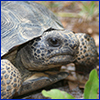 Gopher tortoises may have been around for millions of years, but these days they are threatened by human development that keeps encroaching on their native habitat. Not only are these animals important in their own right, they are a keystone species, meaning that many other creatures in the environment rely on them for survival. If you have a gopher tortoise on your property, keep pets or children away from its burrow. Since they're a threatened species, both the tortoises and their burrows are protected under state law and must be left alone. More
Gopher tortoises may have been around for millions of years, but these days they are threatened by human development that keeps encroaching on their native habitat. Not only are these animals important in their own right, they are a keystone species, meaning that many other creatures in the environment rely on them for survival. If you have a gopher tortoise on your property, keep pets or children away from its burrow. Since they're a threatened species, both the tortoises and their burrows are protected under state law and must be left alone. More
June in Your Garden
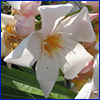 Hurricane season begins, so check around your landscape and make any preparations now. Summer's warm, rainy months are perfect for planting palms. Summer-flowering shrubs like hibiscus, oleander, crapemyrtle, and ixora can be lightly pruned now as they bloom on new growth. Azaleas can still be pruned without harming next season's budding.
Hurricane season begins, so check around your landscape and make any preparations now. Summer's warm, rainy months are perfect for planting palms. Summer-flowering shrubs like hibiscus, oleander, crapemyrtle, and ixora can be lightly pruned now as they bloom on new growth. Azaleas can still be pruned without harming next season's budding.
For more month-by-month gardening tips, check out the Florida Gardening Calendar. Three different editions of the calendar provide specific tips for each of Florida's gardening regions—North, Central, and South.
Gopher Apple
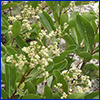 Gopher apple is a native evergreen groundcover that is a favorite wildlife food source. Little white flowers appear in the summer and are followed by the fruits that animals devour. Salt, drought, and fire tolerant, gopher apple is ideal for stabilizing sandy banks; its tolerance of harsh conditions makes it an almost indestructible groundcover. It's an especially great choice for gardeners along the coast. More
Gopher apple is a native evergreen groundcover that is a favorite wildlife food source. Little white flowers appear in the summer and are followed by the fruits that animals devour. Salt, drought, and fire tolerant, gopher apple is ideal for stabilizing sandy banks; its tolerance of harsh conditions makes it an almost indestructible groundcover. It's an especially great choice for gardeners along the coast. More
(Photo of gopher apple by Scott Zona. Some rights reserved.)
What's Going On?
If your Master Gardener program or Extension office is having an event, be sure to share it with us.

